Developing a Qualitative Urban Green Spaces Index Applied to a Mediterranean City
Abstract
:1. Introduction
2. Materials and Methods
2.1. Study Area
2.2. Methodology
2.2.1. Tool Development
2.2.2. Tool Application
3. Results
3.1. UGS QIndex Development and Scoring
3.2. Rampart Gardens Assessment with the UGS QIndex
4. Discussion
5. Conclusions
Author Contributions
Funding
Data Availability Statement
Acknowledgments
Conflicts of Interest
References
- Maurani, T.; Amit-Cohen, I. Open Space Planning Models: A Review of Approaches and Methods. Landsc. Urban Plan. 2007, 81, 1–13. [Google Scholar] [CrossRef]
- Springgate, L. Defining Parks and Park Systems—From Recreation to Re-Creation: New Directions in Parks and Open Space System Planning; American Planning Association: Chicago, IL, USA, 2008. [Google Scholar]
- Pakfegrat, A.; Taghvaei, M.; Zarrabi, A. A comprehensive approach in green space site planning: An application of a three-stage multi-criteria decision support system. Urban Res. Pract. 2020, 13, 45–76. [Google Scholar] [CrossRef]
- Marilyn, M. Decision Making in Allocating Metropolitan Open Space: State of the Art. Trans. Kans. Acad. Sci. 1975, 78, 149–153. [Google Scholar] [CrossRef]
- Dahmann, N.; Wolch, J.; Joassart-Marcelli, P.; Reynolds, K.; Jerrett, M. 2010. The Active City? Disparities in provision of urban public recreation resources. Health Place 2010, 16, 431–445. [Google Scholar] [CrossRef]
- Wolch, J.R.; Byrne, J.; Newell, J.P. Urban green space, public health, and environmental justice: The Challenge of Making Cities ‘just green enough’. Landsc. Urban Plan. 2014, 125, 234–244. [Google Scholar] [CrossRef]
- Wang, Y.; Akbari, H. The effects of Street Tree Planting on Urban Heat Island Mitigation in Montreal. Sustain. Cities Soc. 2016, 27, 122–128. [Google Scholar] [CrossRef]
- Jabbar, M.; Yussof, M.M.; Shafie, A. Assessing the role of urban green spaces for human well-being: A systematic review. GeoJournal 2022, 97, 4405–4423. [Google Scholar] [CrossRef]
- Dadvand, P.; Nieuwenhuijsen, M.J.; Esnaola, M.; Forns, J.; Basagaña, X.; Alvarez-Pedrerol, M.; Rivas, I.; López-Vicente, M.; De Castro Pascual, M.; Su, J.; et al. Green spaces and cognitive development in primary schoolchildren. Proc. Natl. Acad. Sci. USA 2015, 112, 7937–7942. [Google Scholar] [CrossRef]
- Gascon, M.; Mas, M.; Martínez, D.; Dadvand, P.; Forns, J.; Plasència, A.; Nieuwenhuijsen, M. Mental health benefits of long-term exposure to residential green and blue spaces: A systematic review. Int. J. Environ. Res. Public Health 2015, 12, 4354–4379. [Google Scholar] [CrossRef]
- Callaghan, A.; McCombe, G.; Harrold, A.; McMeel, C.; Moore-Cherry, N.; Cullen, W. The impact of green spaces on mental health in urban settings: A scoping review. J. Ment. Health 2020, 30, 179–193. [Google Scholar] [CrossRef]
- Macintyre, S.; Ellaway, A. Ecological approaches: The rediscovery of the role of the physical and social environment. In Social Epidemiology; Berkman, L., Kawachi, I., Eds.; Oxford University Press: Oxford, UK, 2000; ISBN 9780195083316. [Google Scholar]
- Diez-Roux, A.V. Bringing context back into epidemiology: Variables and fallacies in multilevel analysis. Am. J. Public Health 1998, 88, 216–222. [Google Scholar] [CrossRef]
- Van den Berg, A.E.; Maas, J.; Verheij, R.A.; Groenewegen, P.P. Green space as a buffer between stressful life events and health. Soc. Sci. Med. 2010, 70, 1203–1210. [Google Scholar] [CrossRef] [PubMed]
- Jennings, V.; Larson, L.; Yun, J. Advancing sustainability through urban green space: Cultural ecosystem services, equity, and social determinants of health. Int. J. Environ. Res. Public Health 2016, 13, 196. [Google Scholar] [CrossRef] [PubMed]
- Lee, S.A. Coronavirus Anxiety Scale: A brief mental health screener for COVID-19 related anxiety. Death Stud. 2020, 44, 393–401. [Google Scholar] [CrossRef] [PubMed]
- Voigt, A.; Kabisch, N.; Wurster, D.; Haase, D.; Breuste, J. Structural Diversity: A Multi-dimensional Approach to Assess Recreational Services in Urban Parks. AMBIO 2014, 43, 480–491. [Google Scholar] [CrossRef]
- United Nations. Transforming Our World: The 2030 Agenda for Sustainable Development; United Nations: New York, NY, USA, 2015. [Google Scholar]
- Teklemariam, N. Sustainable Development Goals and Equity in Urban Planning: A Comparative Analysis of Chicago, São Paulo, and Delhi. Sustainability 2022, 14, 13227. [Google Scholar] [CrossRef]
- Grêt-Regamey, A.; Celio, E.; Klein, T.M.; Hayek, U.W. Understanding ecosystem services trade-offs with interactive procedural modeling for sustainable urban planning. Landsc. Urban Plan. 2013, 109, 107–116. [Google Scholar] [CrossRef]
- Hyder, M.; Haque, T. Understanding the linkages and importance of urban greenspaces for achieving sustainable development goals 2030. J. Sustain. Dev. 2022, 15, 144. [Google Scholar] [CrossRef]
- Turner-Skoff, J.; Cavender, N. The benefits of trees for livable and sustainable communities. Plants People Planet 2019, 1, 323–335. [Google Scholar] [CrossRef]
- Ghani, F.; Tan, D. The role of green urban spaces in enhancing population health and achieving the sustainable development goals Malays. J. Med. Health Sci. 2020, 16, 380–383. [Google Scholar]
- Knobel, P.; Maneja, R.; Bartoll, X.; Alonso, L.; Bauwelinck, M.; Valentin, A.; Zijlema, W.; Borrell, C.; Nieuwenhuijsen, M.; Davdand, P. Quality of urban green spaces influences residents’ use of these spaces, physical activity, and overweight/obesity. Environ. Pollut. 2021, 271, 116–393. [Google Scholar] [CrossRef]
- Van Den Berg, E.A.; Harting, T.; Staats, H. Preference for Nature in Urbanized Societies: Stress, Restoration, and the Pursuit of Sustainability. J. Soc. Issues 2007, 63, 79–96. [Google Scholar] [CrossRef]
- Sugiyama, T.; Leslie, E.; Giles-Corti, B.; Owen, N. Associations of neighbourhood greenness with physical and mental health: Do walking, social coherence and local social interaction explain the relationships? J. Epidemiol. Community Health 2008, 62, e9. [Google Scholar] [CrossRef]
- Swanwick, C.; Dunnett, N.; Woolley, H. Nature, Role and Value of Green Space in Towns and Cities: An Overview. Built Environ. 2003, 29, 94–106. [Google Scholar] [CrossRef]
- Fan, Y.; Das, K.V.; Chen, Q. Neighborhood green, social support, physical activity, and stress: Assessing the cumulative impact. Health Place 2011, 17, 1202–1211. [Google Scholar] [CrossRef]
- Littke, H.; Locke, R.; Haas, T. Taking the High Line: Elevated parks, transforming neighbourhoods, and the ever-changing relationship between the urban and nature. J. Urban Int. Res. Placemaking Urban Sustain. 2015, 9, 353–371. [Google Scholar] [CrossRef]
- Zhang, L.; Tan, P.Y.; Richards, D. Relative importance of quantitative and qualitative aspects of urban green spaces in promoting health. Landsc. Urban Plan. 2021, 213, 104–131. [Google Scholar] [CrossRef]
- Littke, H. Planning the Green Walkable City: Conceptualizing Values and Conflicts for Urban Green Space Strategies in Stockholm. Sustainability 2015, 7, 11306–11320. [Google Scholar] [CrossRef]
- Rojas-Rueda, D.; Nieuwenhuijsen, M.J.; Gascon, M.; Perez-Leon, D.; Mudu, P. Green Spaces and Mortality: A Systematic Review and Meta-Analysis of Cohort Studies. Lancet Planet Health 2019, 3, 469–477. [Google Scholar] [CrossRef]
- Knobel, P.; Dadvand, P.; Alonso, L.; Costa, L.; Espanol, M.; Maneja, R. Development of the urban green space quality assessment tool (RECITAL). Urban For. Urban Green. 2021, 57, 126895. [Google Scholar] [CrossRef]
- Lee, A.C.K.; Jordan, H.C.; Horsley, J. Value of urban green spaces in promoting healthy living and wellbeing: Prospects for planning. Risk Manag. Healthc. Policy 2015, 8, 131–137. [Google Scholar] [CrossRef]
- Pikora, T.; Giles-Corti, B.; Bull, F.; Jamrozik, K.; Donovan, R. Developing a framework for assessment of the environmental determinants of walking and cycling. Soc. Sci. Med. 2003, 56, 1693–1793. [Google Scholar] [CrossRef]
- Ball, K.; Bauman, A.; Leslie, E.; Owen, N. Perceived environmental aesthetics and convenience and company are associated with walking for exercise among Australian adults. Prev. Med. 2001, 33, 434–440. [Google Scholar] [CrossRef]
- Owen, A.L.; Twist, C.; Ford, P.R. Small-sided games: The physiological and technical effect of altering pitch size and player numbers. OR Insight 2004, 7, 50–53. [Google Scholar]
- Sugiyama, T.; Thompson, C.W. Outdoor Environments, Activity and the Well-Being of Older People: Conceptualising Environmental Support. Environ. Plan. A Econ. Space 2007, 39, 1943–1960. [Google Scholar] [CrossRef]
- Chen, S.; Sleipness, O.; Xu, Y.; Park, K.; Christensen, K. A systematic review of alternative protocols for evaluating non-spatial dimensions of urban parks. Urban For. Urban Green. 2020, 53, 126–718. [Google Scholar] [CrossRef]
- Knobel, P.; Dadvand, P.; Maneja-Zaragoza, R. A systematic review of multidimensional quality assessment tools for urban green spaces. Health Place 2019, 59, 102–198. [Google Scholar] [CrossRef]
- Taïbi, A.N.; El Hannani, M.; Boujrouf, S.; Allouche Khebour, F.; Bensaid, S.; Slimani, H.; Bara, H.; Ajmi, R.; Salhi, S. The place of colonial vegetation in Malagasy and Maghrebian African cities, between abandonment and mimetic reproduction. In Proceedings of the 4th Biennal Conference African Studies Association of Africa (ASAA), Cape Town, South Africa, 11–16 April 2022; Available online: https://hal.science/hal-03704911v1 (accessed on 5 May 2022).
- Allouche Khebour, F.; Ajmi, R.; Bel Fekih Boussema, S.; Serban, G. Ecosystem behaviour face to climatic changes and anthropogenic actions. Case study: A north-eastern urban wetland, Tunisia. Forum Geogr. 2023, 21, 182–185. [Google Scholar] [CrossRef]
- Bousemma Bel Fekih, S.; Khebour Allouche, F.; Saidane, I.; Mechmech, Y.; Bettaieb, T. State of the art of greenway concept application in Tunisian green policy: A case study of an urban landscape in Sousse city. Int. J. Environ. Geoinformat. 2018, 5, 36–50. [Google Scholar] [CrossRef]
- Giles-Corti, B.; Broomhall, M.H.; Knuiman, M.; Collins, C.; Douglas, K.; Ng, K.; Lange, A.; Donovan, R.J. Increasing walking: How important is distance to, attractiveness, and size of public open space? Am. J. Prev. Med. 2005, 28, 169–176. [Google Scholar] [CrossRef]
- Gidlow, C.; Van Kempen, E.; Smith, G.; Triguero-Mas, M.; Kruize, H.; Grazuleviciene, R.; J Ellis, N.; Hurst, G.; Masteron, D.J.; Cirach, M.; et al. Development of the natural environment scoring tool (NEST). Urban For. Urban Green. 2018, 29, 322–333. [Google Scholar] [CrossRef]
- Lorenzo-Sáez, E.; Lerma-Arce, V.; Coll-Aliaga, E.; Oliver-Villanueva, V. Contribution of green urban areas to the achievement of SDGs. Case study in Valencia (Spain). Ecol. Indic. 2021, 131, 108246. [Google Scholar] [CrossRef]
- Csigene Nagypal, N. Valuation challenges of urban green infrastructure. Ecocycles 2022, 8, 1–7. [Google Scholar] [CrossRef]
- Wey, Y.E.; Sarma, V.; Lechner, A.M.; Nath, T.K. Malaysians’ perception on the contribution of urban green spaces to the UN sustainable development goals. Urban For. Urban Green. 2022, 78, 127792. [Google Scholar] [CrossRef]
- Miralles-Guasch, C.; Dopico, J.; Delclos-Alio, X.; Knobel, P.; Marquet, O.; Maneja- Zaragoza, R.; Schipperijn, J.; Vich, G. Natural landscape, infrastructure, and health: The physical activity implications of urban green space composition among the elderly. Int. J. Environ. Res. Public Health 2019, 16, 3986. [Google Scholar] [CrossRef]
- Senetra, A.; Krzywnicka, I.; Mielke, M. An analysis of the spatial distribution, influence and quality of urban green space- a case study of the Polish city of Tczew. Bulletin of Geography. Socio-Econ. Ser. 2018, 42, 129–149. [Google Scholar] [CrossRef]
- Goal 11—Cities Will Play an Important Role in Achieving the SDGs. Available online: https://www.un.org/en/chronicle/article/goal-11-cities-will-play-important-role-achieving-sdgs (accessed on 1 April 2023).
- Liu, H.L.; Shen, Y.S. The impact of green space changes on air pollution and microclimates: A case study of the taipei metropolitan area. Sustainability 2014, 6, 8827–8855. [Google Scholar] [CrossRef]
- Aronson, M.F.J.; La Sorte, F.A.; Nilon, C.H.; Katti, M.; Goddard, M.A.; Lepczyk, C.A.; Warren, P.S.; Williams, N.S.G.; Cilliers, S.; Clarkson, B.; et al. A global analysis of the impacts of urbanization on bird and plant diversity reveals key anthropogenic drivers. Proc. R. Soc. B Biol. Sci. 2014, 281, 20133330. [Google Scholar] [CrossRef]
- Shukuroglou, P.; McCarthy, M.A. Modelling the occurrence of rainbow lorikeets (Trichoglossus haematodus) in Melbourne. Austral. Ecol. 2006, 31, 240–253. [Google Scholar] [CrossRef]
- Hu, Z.; Liebens, J.; Ranga, K.R. Linking stroke mortality with air pollution, income, and greenness in northwest Florida: An ecological geographical study. Int. J. Health Geogr. 2008, 7, 1–22. [Google Scholar] [CrossRef]
- Bird, M.; Datta, G.; Van Hulst, A.; Kestens, Y.; Barnett, T. A reliability assessment of a direct-observation park evaluation tool: The Parks, activity, and recreation among kids (PARK) tool. BMC Public Health 2015, 15, 906. [Google Scholar] [CrossRef] [PubMed]
- Bedimo-Rung, A.L.; Gustat, J.; Bradley, J.T.; Rice, J.; Thomson, J. Development of a Direct Observation Instrument to Measure Environmental Characteristics of Parks for Physical Activity. J. Phys. Act. Health 2006, 3, 176–189. [Google Scholar] [CrossRef]
- Saelens, B.E.; Frank, L.D.; Auffrey, C.; Whitaker, R.C.; Burdette, H.L.; Colabianchi, N. Measuring Physical Environments of Parks and Playgrounds: EAPRS Instrument Development and Inter-Rater Reliability. J. Phys. Act. Health 2006, 3, 190–207. [Google Scholar] [CrossRef] [PubMed]
- Kaczynski, A.T.; Robertson-Wilson, J.; Decloe, M. Interaction of perceived neighborhood walkability and self-efficacy on physical activity. J. Phys. Act. Health 2012, 9, 208–217. [Google Scholar] [CrossRef] [PubMed]
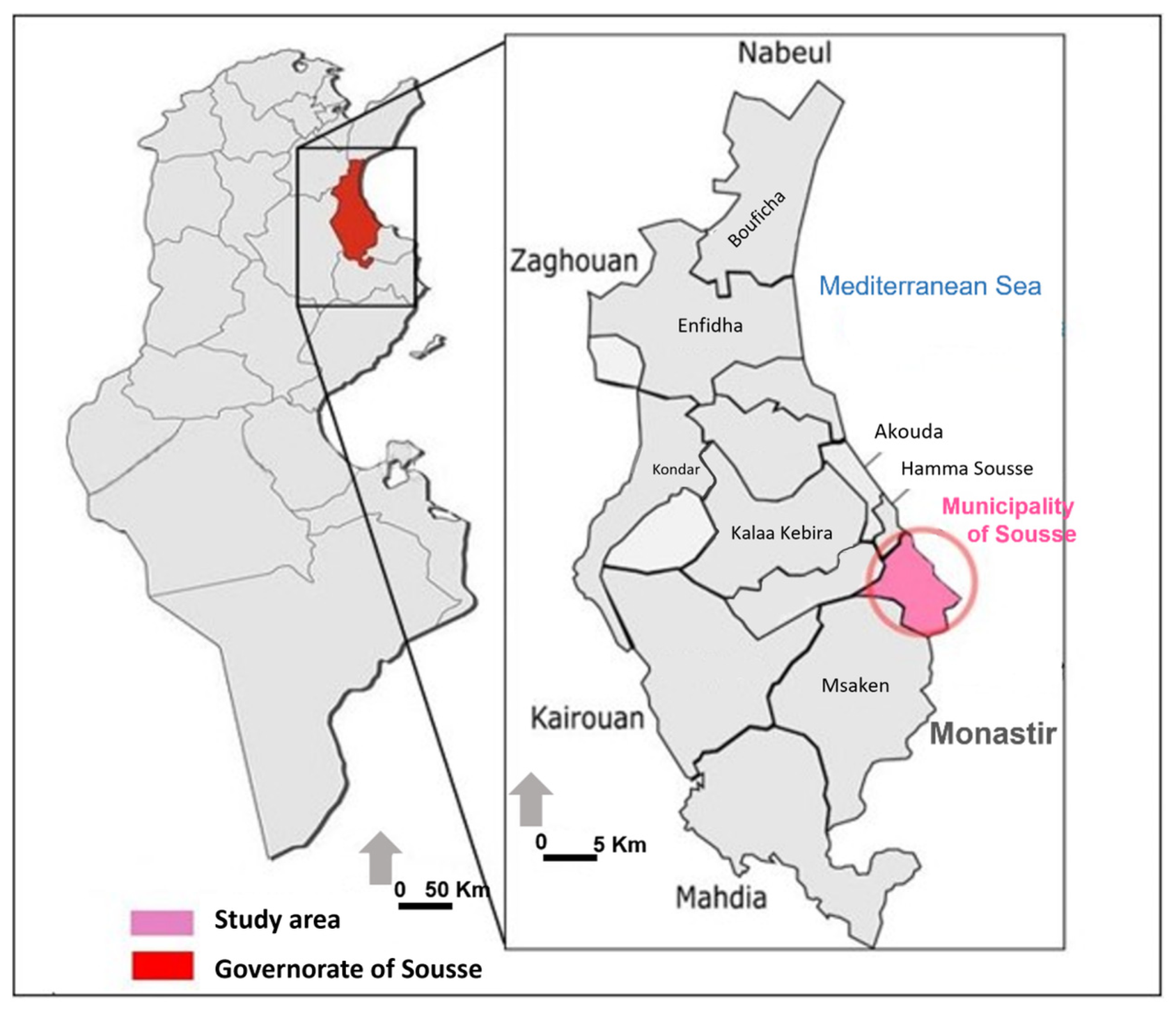
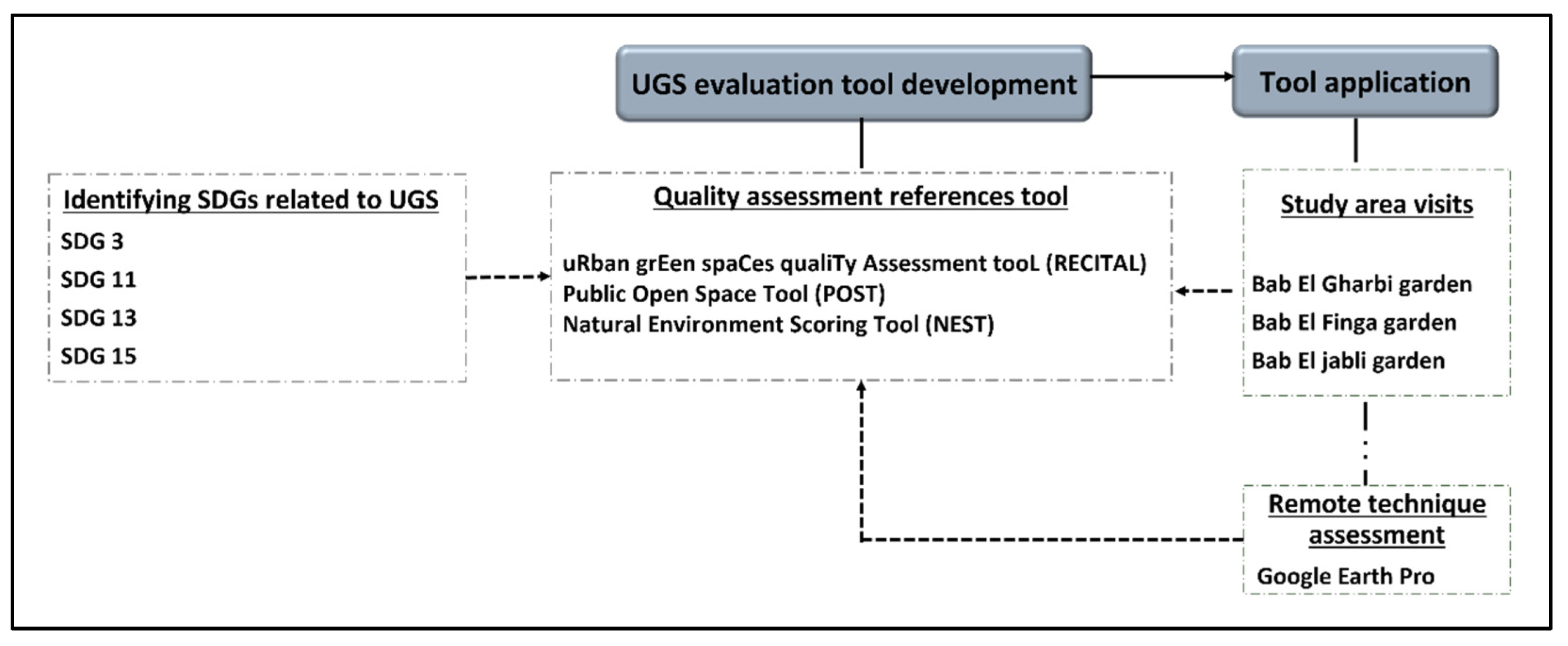
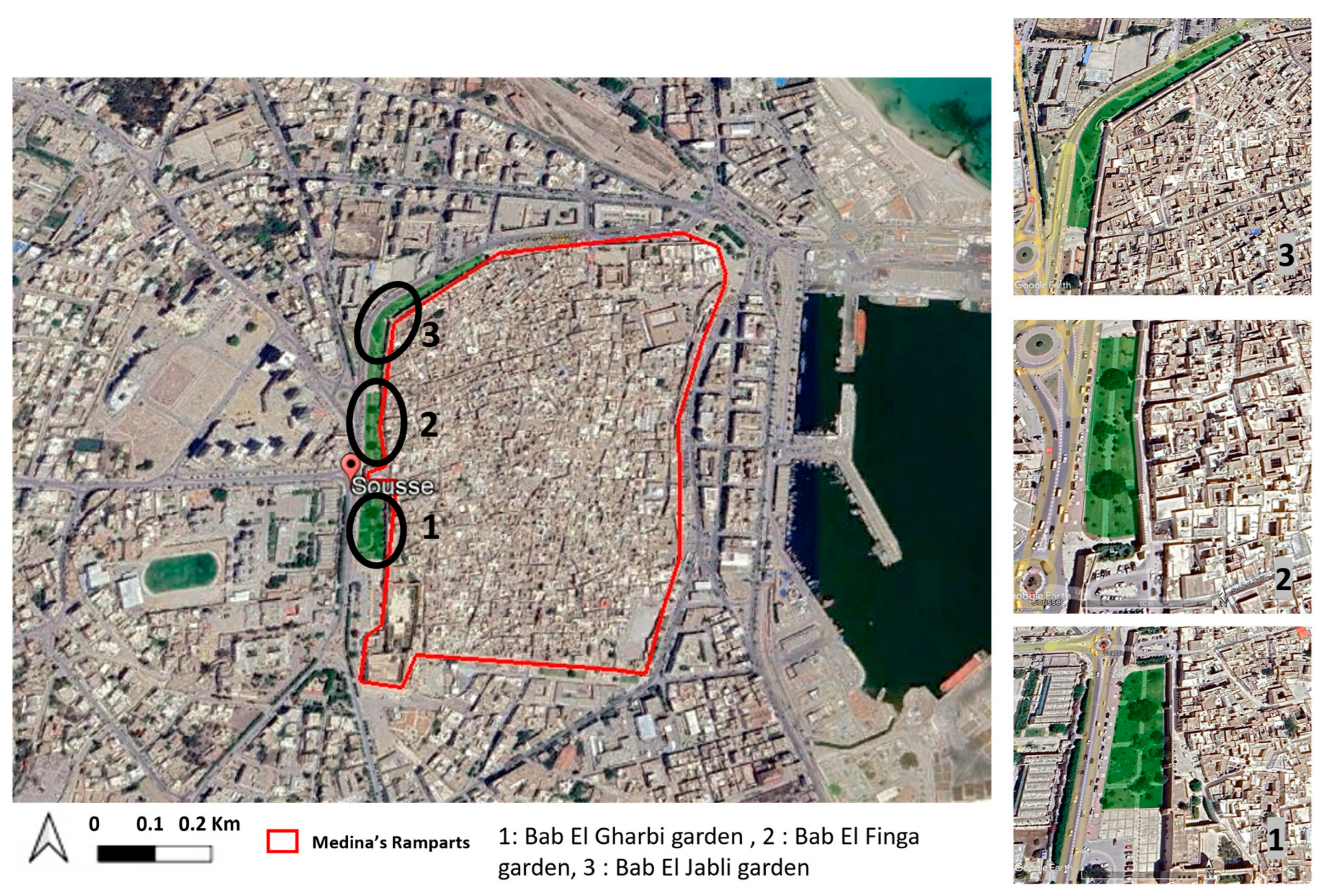
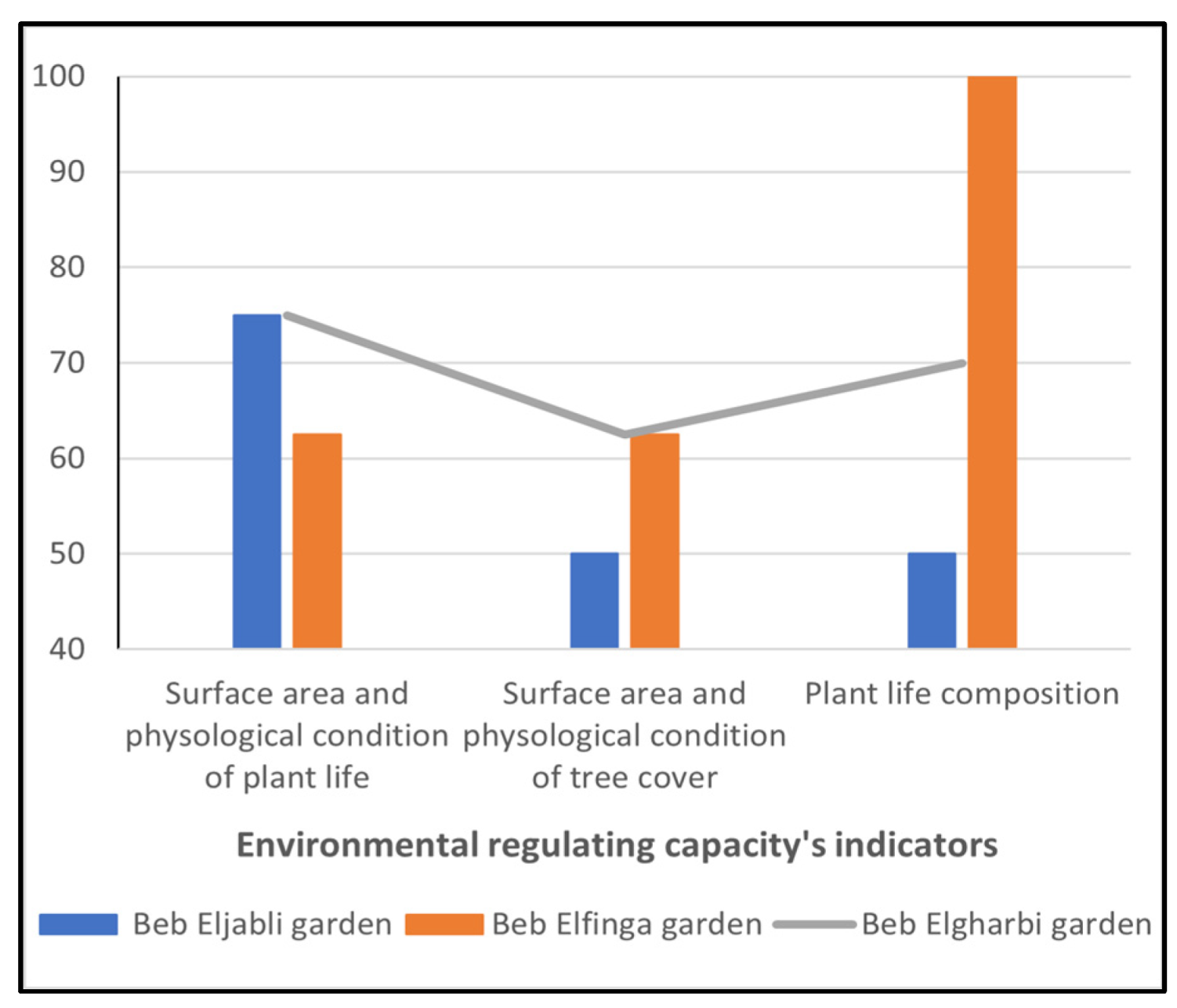


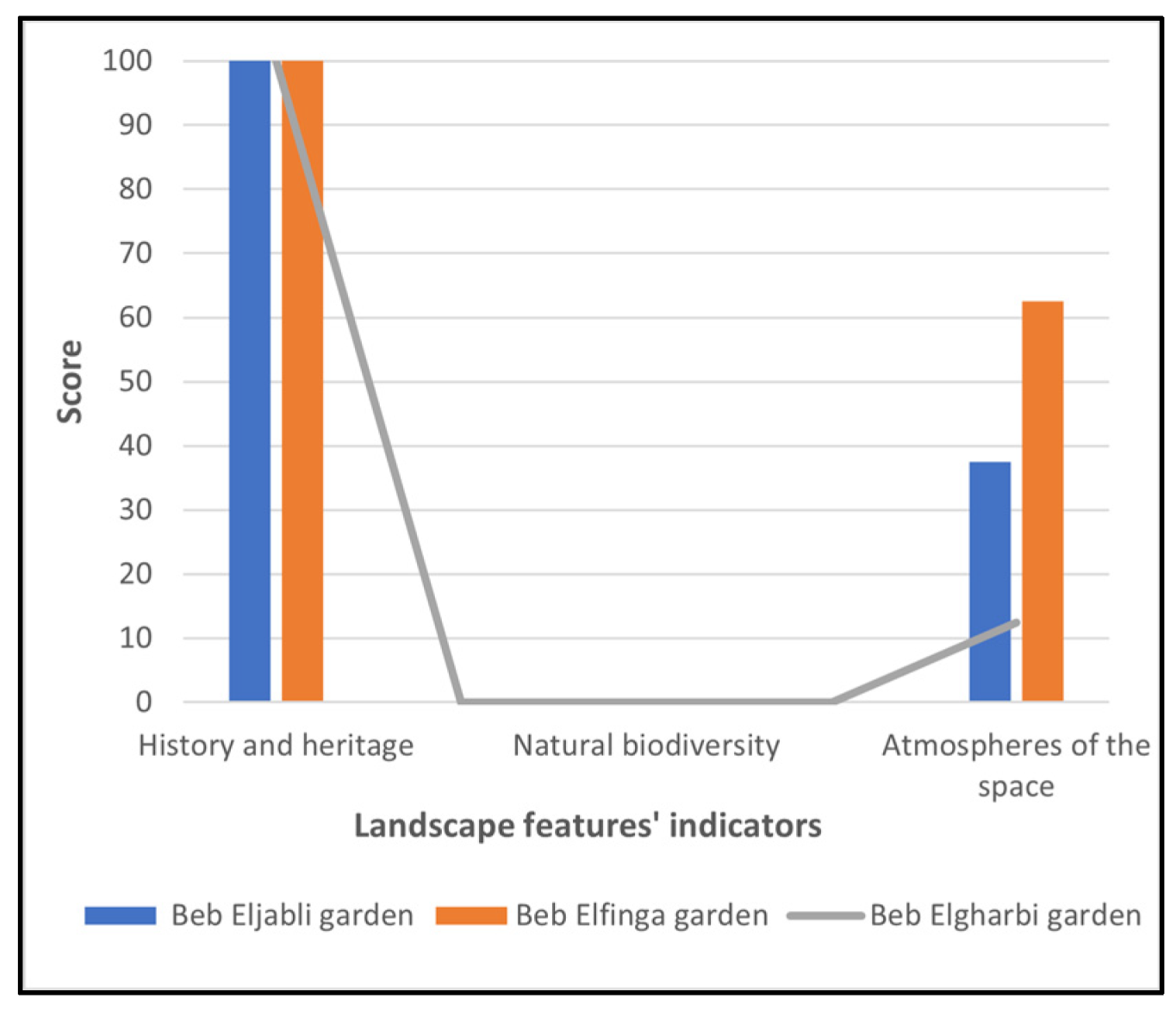
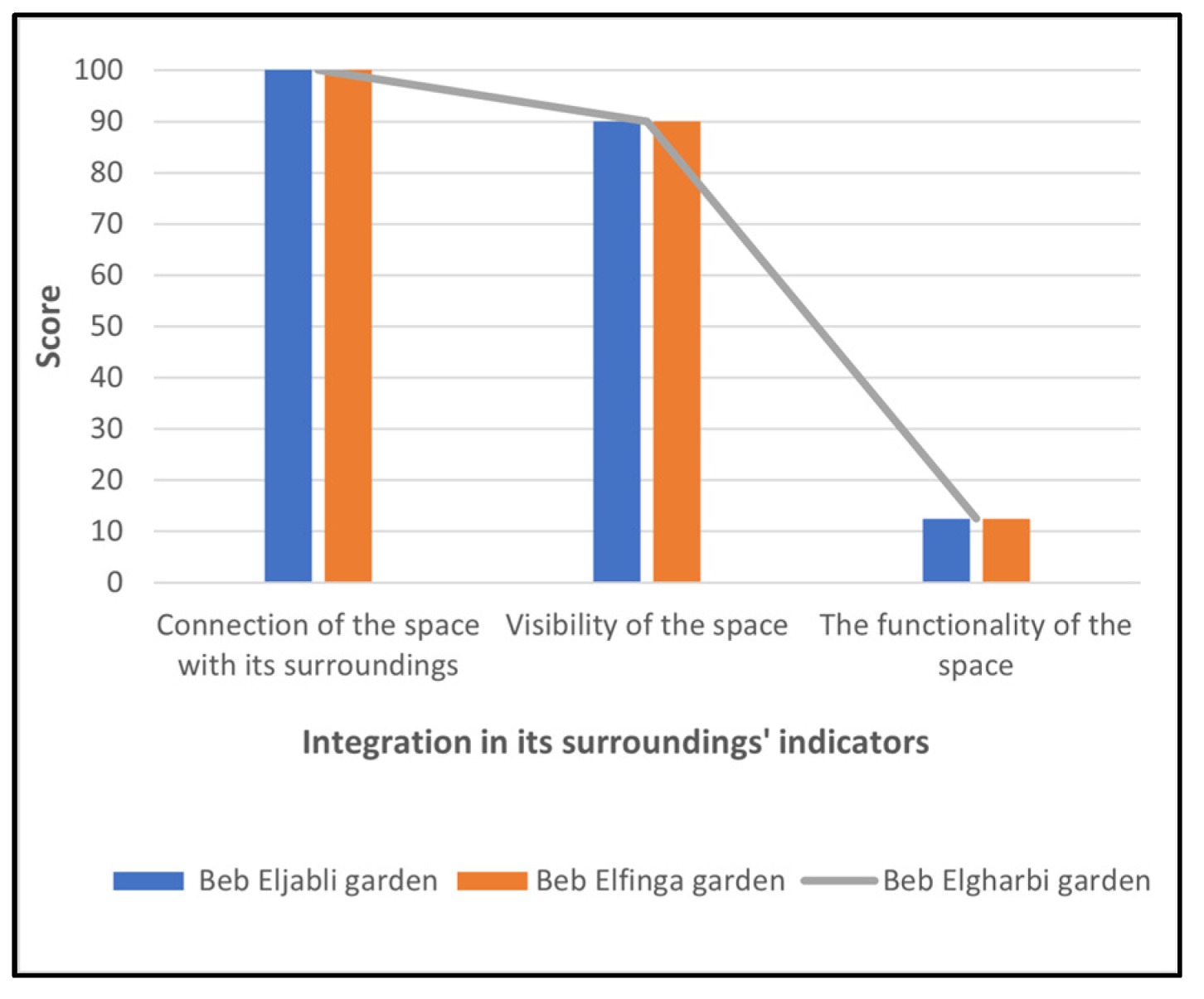
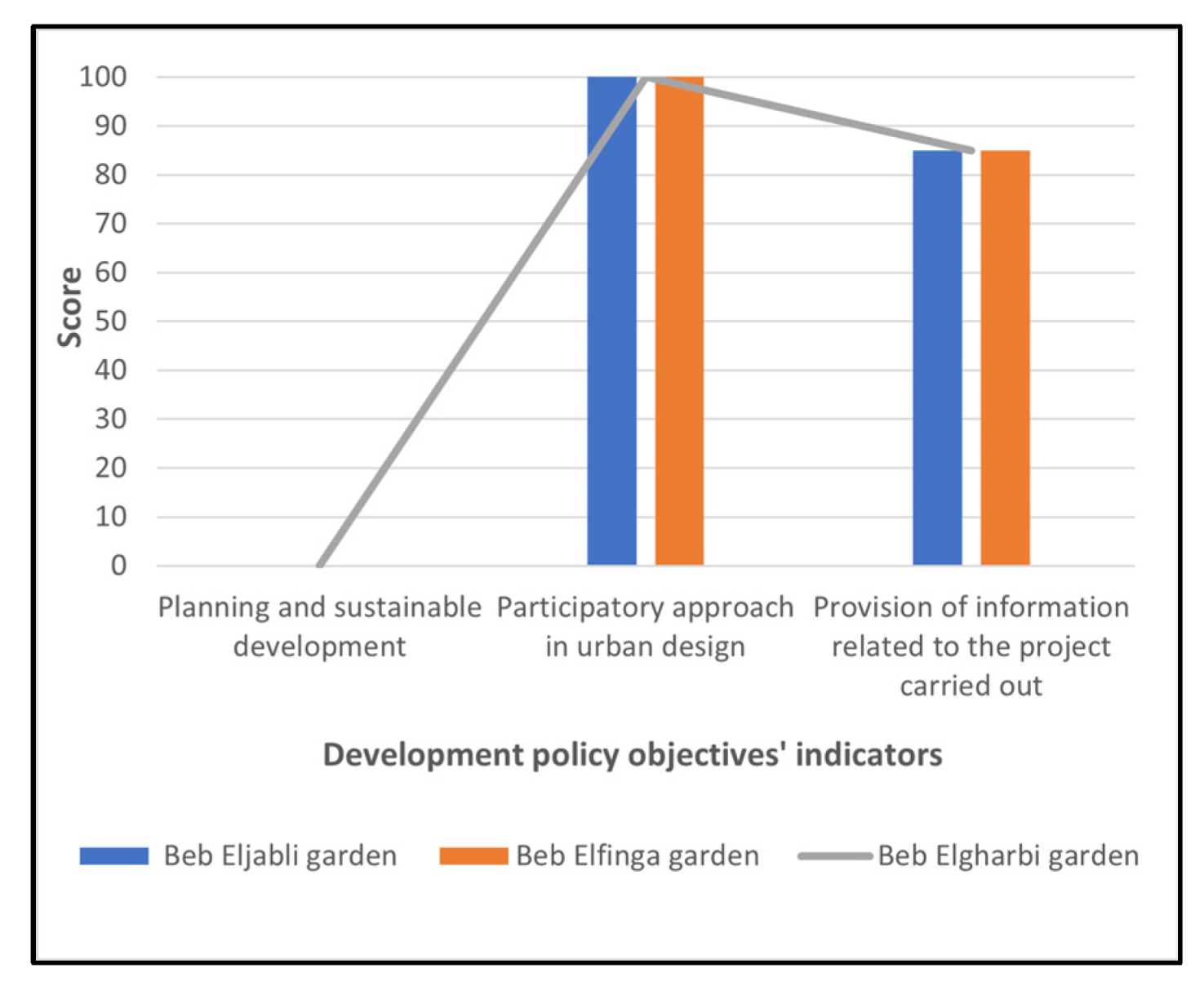

| Sustainable Development Goal | Thematic Criteria | Description |
|---|---|---|
| SDG 13 SDG 15 SDG 11 | Environmental regulating capacity | Based on temperature, energy, etc., it depends on the surface area and the physiological state of the vegetation, as well as the plant life composition. |
| SDG 3 SDG 11 | Functional amenities | Corresponds to the different functional facilities in the UGSs (urban furniture, entrances, playgrounds for children, etc.) |
| SDG 3 SDG 11 | Aesthetic amenities | Depends on the beautification and the requalification functions. |
| SDG 3 SDG 13 SDG 11 | Landscape features | Based on the history, economy, and biodiversity of the UGSs. |
| SDG 3 SDG 11 | Integration in its surroundings | Based on the spatial and social integration of the space in its environment (demands of people, the framework of the space, etc.). |
| SDG 3 SDG 11 | Development policy objectives | Corresponds to the planning process about the Sustainable Development Goals and the participatory approach of the inhabitants. |
| SDG 3 SDG 11 | Space issues | Based on the disadvantages of the space, like the existence of quality-of-life offenses, unpleasant smells, dogs, mosquitoes, noise nuisance, etc. |
| Thematic Criterion | Indicators | Items | Type of Scoring | Source of Information |
|---|---|---|---|---|
| Environmental regulating capacity | Surface area and physiological condition of plant life. | Surface area and physiological condition of the planted surface | Quantity and quality | Remote sensing and/or field visit |
| Surface area and physiological condition of tree cover | Surface area and physiological condition of tree cover | Quantity and quality | Remote sensing and/or field visit | |
| Plant life composition | Number of species | Quantity | Field visit | |
| Functional amenities | Urban furniture development | Benches, seats, and kiosks | Quantity and quality | Field visit |
| Water protection and related facilities | Quantity and quality | Field visit | ||
| Path layout | Presence of users’ tracks | Reverse quantity | Field visit | |
| Path diversity | Quantity and quality | Field visit | ||
| Paths comply with width standards | Standard | Field visit | ||
| Entrance layout | Entrance diversity | Quantity and quality | Field visit | |
| Entrances comply with width standards | Standard | Field visit | ||
| Security | Security guard | Yes/no | Field visit | |
| Space enclosure | Quantity and quality | Field visit | ||
| Surveillance cameras | Quantity and quality | Field visit | ||
| The lighting of the space | Quantity and quality | Field visit | ||
| Multifunctionality | Children’s play facilities | Quantity and quality | Field visit | |
| Sports facilities | Quantity and quality | Field visit | ||
| An open area for activities (sports, socio-cultural, etc.) | Quantity and quality | Field visit | ||
| Biodiversity conservation facilities (botanical gardens, wild gardens, urban forests, etc.) | Quantity | Field visit | ||
| Aesthetic qualities | Embellishment function | Diversity of vegetation (type, colors, textures, etc.) | Quantity and quality | Field visit Field visit |
| Waterpoint | Quantity and quality | Field visit | ||
| Public art | Quantity and quality | Field visit | ||
| Cleanliness | Quantity | Field visit | ||
| Shade | Quantity | Field visit | ||
| Requalification function | Valuation of world heritage or historical element | Yes/no | Field visit | |
| Landscape features | History and heritage | Striking historic event/heritage and/or historical elements | Yes/no | Historical documents |
| Past agricultural biodiversity | Vestiges of past agriculture | Quantity and quality | Field visit Historical documents | |
| Natural biodiversity | Species of pollinators | Quantity and quality | Field visit | |
| Socio-economic interest | Private services with an economic interest | Quantity and quality | Field visit | |
| Atmospheres of the space | Special atmosphere or several types of atmospheres | Quantity | Field visit | |
| Topography (hill/gutter/slope lowering or raising an artificial surface) | Yes/no | Field visit | ||
| Integration in its surroundings | Connection of the space with its surroundings | Linear connections with the outside | Quantity and quality | Field visit |
| Visibility of the space | Surrounded by primary or secondary pathways | Quantity | Field visit | |
| Guidance signs | Quantity and quality | Field visit | ||
| The functionality of the space | Meeting the needs of the population | Quantity | Surveys among the inhabitants | |
| People feel at home in the space | Yes/no | Surveys among the inhabitants | ||
| Development policy objectives | Planning and sustainable development | Development objectives included in the Sustainable Development Goals | Yes/no | Interviews with public decision makers |
| Participatory approach in urban design | Surveys and comments/ meetings with residents/ field observations | Yes/o | Interviews with public decision makers | |
| Provision of information related to the project carried out | Information provided about means of access, schedules, and activities | Yes/no | Interviews with public decision makers | |
| Space issues | Quality-of-life offenses | Vandalism | Reverse quantity | Interviews with public decision makers/field visit |
| Drug use/alcohol use/sexual activity | Reverse quantity | Interviews with public decision makers | ||
| Other drawbacks | Unpleasant odors/noise pollution/visual impact/harmful plants (toxic, allergenic, etc.) | Reverse quantity | Field visit |
| 0% | 25% | 50% | 75% | 100% | |
|---|---|---|---|---|---|
| Quantity | No presence | Almost no presence | Somewhat present | Mostly present | Sufficiently present |
| Reverse quantity | Very present | Mostly present | Somewhat present | Almost no presence | No presence at all |
| Quality | Bad | Poorly maintained and aesthetically unpleasant | Poorly maintained or aesthetically unpleasant | Well-maintained and aesthetically pleasing | Exceptionally well maintained and aesthetically pleasing |
| Quantity and quality | Not present | Not fit for purpose | Suitable but in need of repair or insufficient quantity | Suitable and sufficient | Suitable, sufficient, and aesthetically pleasing |
| Standard | Not met | Almost not met | Somewhat met | Mostly met | Met |
| Yes/no | No | ----------------- | --------------- | ----------------- | Yes |
| Coverage rate | 5% or less | From 5% to 25% | From 25% to 50% | From 50% to 75% | 75% and above |
| Thematic Criteria | Bab El Jabli Garden | Bab El Finga Garden | Bab El Gharbi Garden |
|---|---|---|---|
| Environmental regulating capacity | 58.75 | 73.75 | 78.12 |
| Functional amenities | 51.62 | 65 | 65 |
| Aesthetic qualities | 61.62 | 70.62 | 75.62 |
| Landscape features | 30.62 | 34.37 | 26.87 |
| Integration in its surroundings | 62 | 62 | 62 |
| Development policy objectives | 60 | 60 | 60 |
| Space issues | 79.37 | 83.75 | 83.75 |
Disclaimer/Publisher’s Note: The statements, opinions and data contained in all publications are solely those of the individual author(s) and contributor(s) and not of MDPI and/or the editor(s). MDPI and/or the editor(s) disclaim responsibility for any injury to people or property resulting from any ideas, methods, instructions or products referred to in the content. |
© 2023 by the authors. Licensee MDPI, Basel, Switzerland. This article is an open access article distributed under the terms and conditions of the Creative Commons Attribution (CC BY) license (https://creativecommons.org/licenses/by/4.0/).
Share and Cite
Ajmi, R.; Allouche, F.K.; Taîbi, A.N.; Boussema, S.B.F. Developing a Qualitative Urban Green Spaces Index Applied to a Mediterranean City. Urban Sci. 2023, 7, 115. https://doi.org/10.3390/urbansci7040115
Ajmi R, Allouche FK, Taîbi AN, Boussema SBF. Developing a Qualitative Urban Green Spaces Index Applied to a Mediterranean City. Urban Science. 2023; 7(4):115. https://doi.org/10.3390/urbansci7040115
Chicago/Turabian StyleAjmi, Rania, Faiza Khebour Allouche, Aude Nuscia Taîbi, and Safa Bel Fekih Boussema. 2023. "Developing a Qualitative Urban Green Spaces Index Applied to a Mediterranean City" Urban Science 7, no. 4: 115. https://doi.org/10.3390/urbansci7040115
APA StyleAjmi, R., Allouche, F. K., Taîbi, A. N., & Boussema, S. B. F. (2023). Developing a Qualitative Urban Green Spaces Index Applied to a Mediterranean City. Urban Science, 7(4), 115. https://doi.org/10.3390/urbansci7040115








